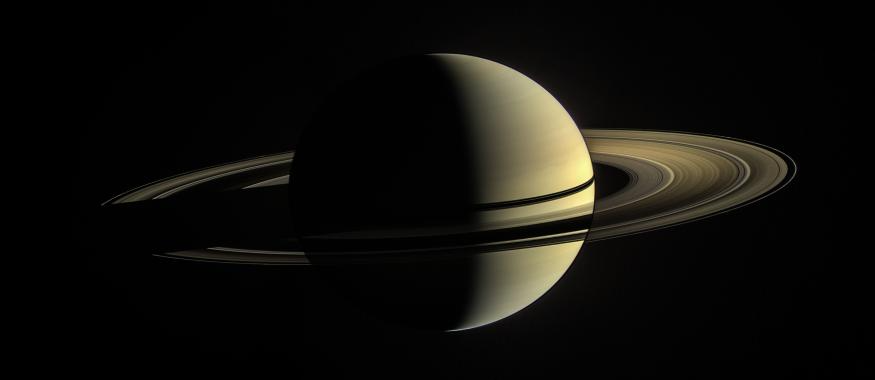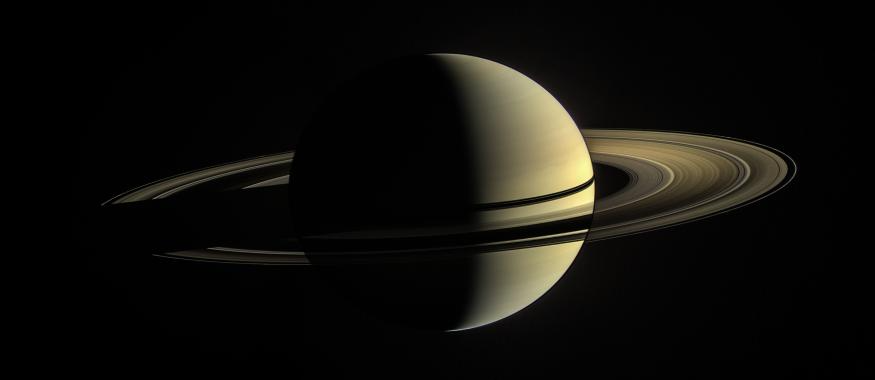Space Dirt Reveals Age of Saturn’s Rings
With its wide bands of encircling dust, Saturn’s rings are the biggest and brightest in our Solar System. They are also the most mysterious. Unanswered questions remain about why, how, and when the seven rings formed. Now Sascha Kempf of the University of Colorado Boulder and colleagues have addressed the latter problem, using dust contaminants within the rings to place an upper limit of 400 million years on the rings’ age [1]. Kempf says that for as long as he’s been in the field, astronomers have been discussing whether Saturn’s rings are as old as the planet or if they are younger. Now they know. “They are significantly younger,” he says.
Kempf and colleagues produced their age estimate by studying the contamination rate of the rings by small pieces of rock and debris, known as micrometeoroids. These contaminants are constantly zooming around our Solar System, colliding with objects in their paths. When one of these micrometeoroids hits one of Saturn’s rings it can get incorporated into the ice the rings contain. Kempf and colleagues realized they could use the rate at which this process happens as a clock to reveal the rings’ age.
Most of the contamination of Saturn’s rings comes from Saturn’s moon Enceladus, which has geysers that shoot out ice and water. This contamination contains very little rocky, carbon-based material, says Andrew Poppe, a space scientist at the University of California, Berkeley, who was not involved in the new study. As such, the dark pollutants within Saturn’s rings predominantly come from beyond the Saturnian system. In addition, Poppe notes that the pollution from Enceladus moves very slowly, while dust originating from outside of the Saturnian system moves much faster. Interstellar dust also spirals inward toward the planet’s surface. It was these interplanetary explorers that the researchers searched for in their study.
Kempf and his team used the Cosmic Dust Analyzer aboard the Cassini spacecraft for their flux measurements. From 2004 to 2017, when Cassini was intentionally destroyed by being plunged into Saturn’s atmosphere, this instrument collected over 2 million grains of dust and rock from around Saturn, recording each grain’s velocity. The team used this velocity information to determine the likely origin of each grain, filtering out those that came from Enceladus to leave only the interplanetary ones. Of the 2 million particles collected, this filtering left around 160, Kempf says. “It [was] a needle in the haystack problem.”
These 160 particles indicate an interplanetary dust contamination rate of less than a gram of dust per square foot of ring per year. Using this rate and the value of the total contamination of the rings, which measurements show lies between 0.1% and 2%, the researchers placed the age of the rings between 100 million and 400 million years old. “Saturn’s rings are incredibly clean,” which indicates that they are much younger than the planet they surround, Kempf says.
Now that scientists have clear bounds on the rings’ age, theorists will need to develop models that can explain how Saturn’s rings formed on such a short timescale, says Sean Hsu, a research associate at the University of Colorado Boulder. He was not involved in the study. “I think this [result] will really excite modelers.” Hsu says that many scientists assumed that the Solar System as we see it today was set in place billions of years ago. The new results appear to negate that assumption, as they indicate that some of the Solar System’s structures formed relatively recently in planetary history. Other results show that those structures might still be in flux. For example, previously released data indicated that particles within Saturn’s rings are being pulled by gravity out of the rings, toward the planet, creating a dust-ice rain. That process is so rapid that Saturn’s rings are expected to disappear within 100 million years. Given their short and dynamic life, we got “lucky” to see Saturn’s “magnificent” rings as we do now, Hsu says.
–Allison Gasparini
Allison Gasparini is a freelance science writer based in Santa Cruz, CA.
References
- S. Kempf et al., “Micrometeoroid infall onto Saturn’s rings constrains their age to no more than a few hundred million years,” Sci. Adv. 9 (2023).





